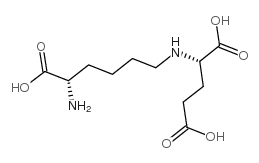Saccharopine

Saccharopine structure
|
Common Name | Saccharopine | ||
|---|---|---|---|---|
| CAS Number | 997-68-2 | Molecular Weight | 276.28600 | |
| Density | 1.333g/cm3 | Boiling Point | 537.2ºC at 760mmHg | |
| Molecular Formula | C11H20N2O6 | Melting Point | N/A | |
| MSDS | Chinese USA | Flash Point | 278.7ºC | |
|
Attenuation of autophagic-proteolysis in C2C12 cells by saccharopine.
Mol. Cell Biochem. 410 , 93-100, (2015) Muscle wasting impairs physical function and leads people to a bedridden state. We previously demonstrated that lysine (Lys) suppresses autophagic-proteolysis through the Akt pathway. However, the effect of metabolites of Lys on proteolysis is unclear. In thi... |
|
|
Molecular cloning and expression of human L-pipecolate oxidase.
Biochem. Biophys. Res. Commun. 270(3) , 1101-5, (2000) In higher eukaryotes L-lysine can be degraded via two distinct routes including the saccharopine pathway and the L-pipecolate pathway. The saccharopine pathway is the primary route of degradation of lysine in most tissues except the brain in which the L-pipec... |
|
|
Lysine catabolism in Haemonchus contortus and Teladorsagia circumcincta.
Exp. Parasitol. 131(1) , 101-6, (2012) Catabolism of lysine through the pipecolate, saccharopine and cadaverine pathways has been investigated in L3 and adult Haemonchus contortus and Teladorsagia circumcincta. Both enzymes of the saccharopine pathway (lysine ketoglutarate reductase (LKR) and sacc... |
|
|
Potential role for saccharopine reductase in swainsonine metabolism in endophytic fungus, Undifilum oxytropis.
Fungal Biol. 116(8) , 902-9, (2012) Locoweed plants in the southwestern United States often harbour a slow-growing endophytic fungus, Undifilum oxytropis (Phylum: Ascomycota; Order: Pleosporales), which produces a toxic alkaloid, swainsonine. Consumption of U. oxytropis by grazing animals induc... |
|
|
A QM/MM-based computational investigation on the catalytic mechanism of saccharopine reductase.
Molecules 16(10) , 8569-89, (2011) Saccharopine reductase from Magnaporthe grisea, an NADPH-containing enzyme in the α-aminoadipate pathway, catalyses the formation of saccharopine, a precursor to L-lysine, from the substrates glutamate and α-aminoadipate-δ-semialdehyde. Its catalytic mechanis... |
|
|
Lysine metabolism in the human and the monkey: demonstration of pipecolic acid formation in the brain and other organs.
Neurochem. Res. 7(5) , 577-88, (1982) Metabolism of L-[U-14C]lysine was studied in the human autopsy tissues and the intact monkeys through intracerebroventricular and intravenous injections. The human tissues were more active in the metabolism of L-[14C]lysine to [14C]pipecolate than the rat tis... |
|
|
Recurrent, familial Reye-like syndrome with a new complex amino and organic aciduria.
Eur. J. Pediatr. 149(10) , 709-12, (1990) Five of 13 siblings from a Jewish-Ashkenazi family suffered from recurrent Reye-like episodes. During attacks, these patients excreted alpha-keto-adipic, alpha-hydroxy-adipic, and alpha-aminoadipic acids, branched-chain keto acids and saccharopine in addition... |
|
|
Catabolism of lysine in Penicillium chrysogenum leads to formation of 2-aminoadipic acid, a precursor of penicillin biosynthesis.
Appl. Environ. Microbiol. 60(6) , 1705-10, (1994) Penicillium chrysogenum L2, a lysine auxotroph blocked in the early steps of the lysine pathway before 2-aminoadipic acid, was able to synthesize penicillin when supplemented with lysine. The amount of penicillin produced increased as the level of lysine in t... |
|
|
Lysine degradation through the saccharopine pathway in mammals: involvement of both bifunctional and monofunctional lysine-degrading enzymes in mouse.
Biochem. J. 344 Pt 2 , 555-63, (1999) Lysine-oxoglutarate reductase and saccharopine dehydrogenase are enzymic activities that catalyse the first two steps of lysine degradation through the saccharopine pathway in upper eukaryotes. This paper describes the isolation and characterization of a cDNA... |
|
|
Familial hyperlysinemia: enzyme studies, diagnostic methods, comments on terminology.
Am. J. Hum. Genet. 31(3) , 290-9, (1979) Enzyme assays of skin fibroblasts from five children with familial hyperlysinemia from unrelated families are added to the previous report of three children from two unrelated families. In all instances there was a deficiency in lysine-ketoglutarate reductase... |